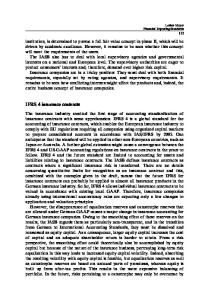Financial Reporting The theoretical and regulatory framework
- PDF / 42,716,618 Bytes
- 474 Pages / 439.383 x 666.132 pts Page_size
- 43 Downloads / 413 Views
FINANCIAL REPORTING The theoretical and regulatory framework SECOND EDITION
David Alexander Department of European Business Leeds Business School, UK
s
SPRINGER-SCIENCE+BUSINESS MEDIA, B.V.
First edition 1986 Reprinted 1988,1989 Second edition 1990
©
1990 D.J.A. Alexander
Originally published by Chapman and Hall in 1990 Typeset in 10/12pt Times by EJS Chemical Composition, Bath, Avon ISBN 978-0-412-35790-9 DOI 10.1007/978-1-4899-7118-0
ISBN 978-1-4899-7118-0 (eBook)
All rights reserved. No part of this publication may be reproduced or transmitted, in any form or by any means, electronic, mechanical, photocopying, recording or otherwise, or stored in any retrieval system of any nature, without the written permission of the copyright holder and the publisher, application for which shall be made to the publisher. British Library Cataloguing in Publication Data Alexander, David, 1941Financial reporting.-2nd ed 1. Companies. Financial reports I. Title 658.1512 Library of Congress Cataloguing-in-Publication Data Alexander, David. Financial reporting: the threoretical and regulatory framework/ David Alexander.-2nd ed. p. em.
1. Accounting. 2. Accounting-Lawandlegislation. HF5635.A27 1990 657-dc20
I. Title.
90-1348 CIP
Contents Preface Abbreviations
:xiii XV
PART ONE: THE CONCEPTUAL FRAMEWORK 1 Accounting theory, or Accounting can be interesting Introduction An analogy - all about sausages The focus of this book Exercises
2 Some basic ideas Introduction Wealth Wealth (again) Exercises
3 Income concepts - a more formal consideration Economic income Current value accounting Capital maintenance Accounting for changes in the purchasing power of money Current cost accounting Advantages and disadvantages Exercises 4
The objectives of financial statements and their usefulness to the general user groups Introduction The Corporate Report The user groups Summary of user needs Characteristics of useful information The need for communication Conclusion Exercises
3
3 4 6 7 9
9 10 18 21 22 22 30 39 43 51 58 61 64 64 64
65 69 70 72
73 74
vi
Contents
5 Traditional accounting conventions Introduction The 'framework' conventions The 'practical' conventions A coherent framework Exercises
75 75 75 79 81 84
6 The recognition of revenue The problem illustrated The problem considered The compromise solution Dropping the 'HC convention' Holding gains and realization Exercises
85 85 86 88 89 90 91
Towards a general framework?
93 93 94 94 97 98 100 116 117
7
Introduction The elements of accounting The balance sheet Profit and loss A conceptual framework for the 1990s? The IASC framework Conclusions Exercises
8 A critical review of the theoretical framework Introduction The crunch questions! Some empirical evidence Exercise
119 119 119 120 121
9 Some possible extensions to the accounting framework Introduction Statement of source and application of funds (SSAP 10) Cash flow accounting and cash flow statements Statements recommended by The Corporate Report Social accounting Disaggregation or segmental reporting











